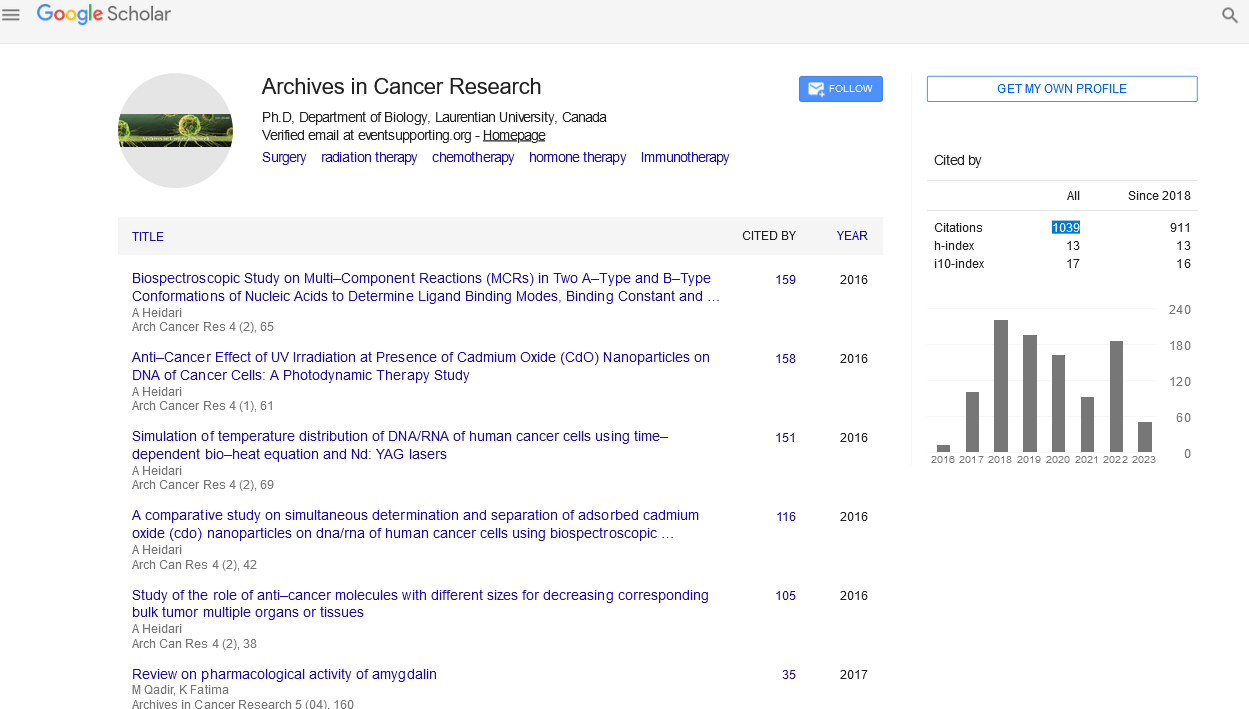Perspective - (2024) Volume 12, Issue 6
Tumor Microenvironment: A Key Determinant of Cancer Progression
Johnny Noble*
Department of Science and Engineering, National University of Ireland Galway, Galway, Ireland
*Correspondence:
Johnny Noble, Department of Science and Engineering, National University of Ireland Galway, Galway,
Ireland,
Email:
Received: 14-Nov-2024, Manuscript No. IPACR-24-15350;
Editor assigned: 19-Nov-2024, Pre QC No. IPACR-24-15350 (PQ);
Reviewed: 03-Dec-2024, QC No. IPACR-24-15350;
Revised: 13-Dec-2024, Manuscript No. IPACR-24-15350 (R);
Published:
20-Dec-2024
Introduction
The Tumor Micro Environment (TME) is the environment
surrounding a tumor, including not only the tumor cells
themselves but also the various non-cancerous cells, Extracellular
Matrix (ECM), blood vessels, and signaling molecules that support
and interact with the tumor. Far from being a passive bystander,
the TME plays a crucial role in cancer progression, metastasis, and
therapeutic resistance. Understanding the TME is vital for
developing targeted therapies that can enhance cancer treatment
outcomes and overcome the limitations of conventional therapies
like chemotherapy and radiotherapy.
Description
Components of the tumor microenvironment
The TME is composed of several key elements, each
contributing to tumor behavior. These components include.
Cancer cells: The core of the tumor consists of malignant cells
that exhibit uncontrolled growth. These cells undergo genetic
mutations and epigenetic changes that enable them to evade
normal regulatory mechanisms and thrive in abnormal
conditions.
Cancer-Associated Fibroblasts (CAFs): CAFs are one of the
most abundant cell types in the TME. These fibroblasts
contribute to the ECM’s composition and produce growth
factors that promote tumor progression. CAFs also influence
immune cell behavior and can even help tumors evade immune
surveillance.
Endothelial cells: These cells line the blood vessels and play a
pivotal role in angiogenesis (the formation of new blood
vessels). Tumors need a supply of oxygen and nutrients to grow
beyond a certain size, and angiogenesis is a key mechanism by
which tumors achieve this.
Immune cells: The immune cells present in the TME can
either promote or inhibit tumor growth, depending on their
type and state of activation. Tumor-Associated Macrophages
(TAMs), Regulatory T Cells (Tregs), and Myeloid-Derived
Suppressor Cells (MDSCs) often support tumor growth and metastasis by suppressing immune responses, while Cytotoxic T
Lymphocytes (CTLs) can kill cancer cells if activated.
Extracellular Matrix (ECM): The ECM is a complex network of
proteins and molecules that provide structural support to the
tumor and regulate various cellular functions. It is frequently
altered in tumors, and these alterations can contribute to tumor
invasion and metastasis. The ECM also modulates cell signaling,
influencing cancer cell behavior and therapeutic responses.
Tumor blood vessels: Tumor blood vessels are often irregular,
leaky, and poorly structured, contributing to abnormal blood
flow and the formation of regions with low oxygen (hypoxia).
This altered vascularization further complicates the delivery of
therapeutic agents to the tumor and can lead to resistance to
treatments like chemotherapy.
Impact of tumor microenvironment on cancer
progression
The TME plays a critical role in shaping the behavior of tumor
cells and influencing cancer progression. Several key processes
are modulated by the TME, including:
Tumor growth: Tumor cells rely on the TME for various factors
that stimulate their growth. Growth factors like Vascular
Endothelial Growth Factor (VEGF) and Fibroblast Growth Factor
(FGF), which are secreted by CAFs and other cells in the TME,
promote tumor cell proliferation and survival. The TME also
helps to provide the necessary oxygen and nutrients that tumors
need to grow.
Angiogenesis and metastasis: As tumors grow, they require a
blood supply to meet their metabolic needs. The TME supports
angiogenesis, enabling tumors to form new blood vessels.
However, these vessels are often abnormal and leaky, creating a
hypoxic environment that can promote metastasis. Hypoxia
triggers the release of pro-angiogenic and pro-metastatic
factors, such as VEGF and Matrix Metallo Proteinases (MMPs),
which facilitate tumor cell invasion and migration.
Immune evasion: Tumors are capable of manipulating the
immune system to avoid destruction. Immune cells in the TME,
such as TAMs and MDSCs, often have a pro-tumor phenotype
that inhibits effective immune responses. For example, TAMs
can release cytokines that promote tumor growth and inhibit
the activation of cytotoxic T cells. Regulatory T cells (Tregs) suppress the immune response by inhibiting the function of
effector T cells, thus allowing the tumor to escape immune
surveillance.
Therapeutic resistance: One of the most significant challenges
in cancer treatment is the development of resistance to therapy.
The TME can influence resistance to chemotherapy, radiotherapy,
and immunotherapy. For instance, the low oxygen levels within
tumors can make tumor cells more resistant to radiation
therapy, which relies on oxygen to produce DNA-damaging free
radicals. Additionally, CAFs and other stromal cells can secrete
factors that protect tumor cells from chemotherapy-induced cell
death.
Therapeutic implications and targeting the tumor
microenvironment
Understanding the critical role of the TME in cancer
progression has opened up new opportunities for targeted
therapies that aim to modulate the TME itself. Several strategies
have been explored to target different components of the TME:
Targeting Cancer-Associated Fibroblasts (CAFs): CAFs play a
central role in shaping the TME and promoting tumor
progression. Therapies aimed at depleting CAFs or blocking their
signaling pathways are being developed. For example, inhibiting
Fibroblast Activation Protein (FAP), a protein expressed on CAFs,
could reduce their pro-tumorigenic effects.
Angiogenesis inhibition: Anti-angiogenic therapies, such as
bevacizumab (an anti-VEGF antibody), aim to block the
formation of new blood vessels and restrict the tumor’s nutrient
supply. Although such therapies have had limited success in
some cancers, ongoing research seeks to improve their efficacy
by combining them with other treatment modalities.
Immune modulation: One of the most promising areas of
cancer therapy is immune checkpoint inhibition. Drugs such as pembrolizumab and nivolumab, which target immune
checkpoint molecules like PD-1 and PD-L1, have shown
significant success in various cancers. These therapies work by
reactivating the immune response, allowing immune cells to
recognize and kill cancer cells. Additionally, strategies to deplete
immunosuppressive cells like Tregs and MDSCs are being
explored to enhance immune-mediated tumor killing.
Targeting the extracellular matrix: The ECM influences tumor
cell behavior, and targeting its components could disrupt tumor
progression. Therapies that degrade the ECM or block the
signaling pathways associated with ECM remodeling could
hinder tumor invasion and metastasis. MMP inhibitors, for
example, are being investigated for their ability to block ECM
degradation and reduce tumor spread.
Hypoxia-targeted therapies: Hypoxia is a common feature of
solid tumors, and strategies to target hypoxic regions are under
investigation. Agents that can improve oxygen delivery or
sensitize tumor cells to radiation by reducing hypoxia could
enhance therapeutic efficacy.
Conclusion
The tumor microenvironment plays a pivotal role in cancer
progression, metastasis, immune evasion, and resistance to
therapy. Understanding its complex components and the
dynamic interactions between tumor cells and their
surroundings is essential for developing novel therapeutic
strategies. Targeting the TME offers a promising approach to
overcome the limitations of traditional cancer therapies and
improve patient outcomes. Continued research into the TME will
likely uncover even more opportunities for therapeutic
intervention, leading to more effective treatments for cancer
patients.
Citation: Noble J (2024) Tumor Microenvironment: A Key Determinant of Cancer Progression. Archives Can Res Vol:12 No:6





